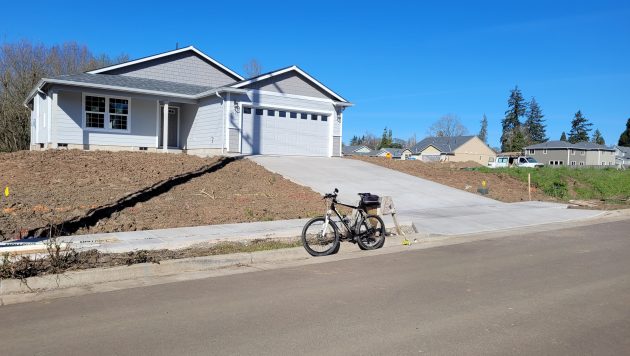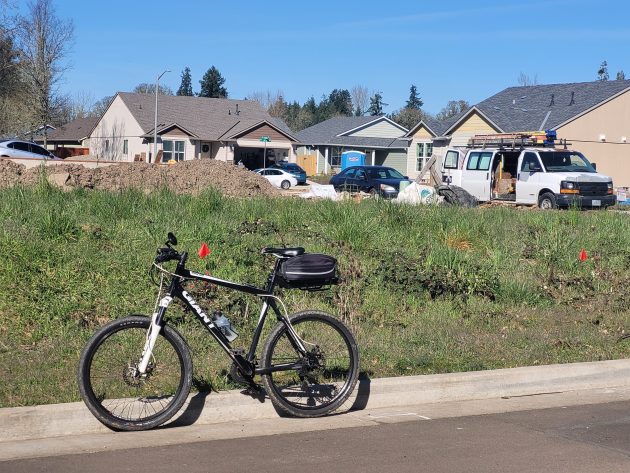
A handsome new house in the Takena Estates subdivision in southwest Albany on March 16.
Bike rides in Albany occasionally take me into a new subdivision on the west end of town, where they’ve been building and selling three- and four-bedroom houses since 2019.
It’s the 32-lot Takena Estates subdivision. And as I stopped there Saturday to look around, I was thinking about the Oregon “housing crisis” that we hear so much about.
Governor Kotek and the just-concluded 2024 legislature congratulated themselves for passing a $376 million housing package intended to help fulfill the governor’s stated goal of 36,000 houses being built in Oregon per year.
Now, annual housing production in Oregon is roughly 22,000 units, according to a story on OPB.
So what is holding up housing production? There’s a long list of causes. Depending on whom you ask, the list includes permit requirements, the time it takes to get permits, a shortage of construction labor, the cost of supplies including lumber and, above all, interest rates.
Did the legislature’s housing package lower any of those hurdles? No.
Instead, the package will pump money into an array of state agencies and create a new one called the Housing Accountability and Production Office or HAPO.
The legislature’s package included two main bills, SB 1537A and SB 1530A. You should look them up.
Here, for starters, is the summary of the five pages of small type that describe “what the measure does” for SB 1537A:
“The measure establishes the Housing Accountability and Production Office (HAPO) and directs HAPO to assist local governments with housing production. The measure requires local governments to grant land use regulation and design adjustments in certain circumstances and modifies the definition of limited land use decisions. It allows housing permit applicants to opt in to amended housing regulations and expands eligibility of prevailing applicants for housing development to receive attorney fees in a Land Use Board of Appeals review. Establishes the Housing Infrastructure Support Fund to provide capacity and support to municipalities for the planning and financing of infrastructure for housing unit production. Establishes the Housing Project Revolving Loan Fund to cover eligible developer costs, including infrastructure and system development charges, predevelopment costs, construction costs, and land write-downs. The measure allows cities to undergo either a one-time urban growth boundary amendment or a land exchange in specified conditions.”
The other measure, SB 1530A, appropriates $258 million to five agencies or departments: Housing and Community Services, Administrative Services, Health Authority, Energy, and Human Services.
The money is intended for lots of things, the biggest item being $100 million to pay for infrastructure that supports housing. One of the smallest is $4 million for the “residential heat pump fund.”
To the extent any of this cash results in more housing being built, it will take years. All the spending will have to be funneled through state bureaucracies, which in general are not famous for their speed.
On Saturday afternoon, a couple of newly built houses at Takena Estates looked just about ready for occupancy. And a couple of guys were working on the foundation of a third.
About half the 32 lots already have people living in their new houses. Eventually all the lots will be filled, but it won’t be because of what the Oregon legislature did this month. (hh)

Housing construction continues at the Takena Estates subdivision, as seen from 15th Avenue.

Yawn…
Thomas Jefferson said: “The government you elect is the government you deserve.”
Oregon government adds new layers of bureaucracy and additional spending. More bureaucrats are empowered to make more arbitrary dictates.
All to “solve” a problem of their own making.
Nothing to see here, move along folks…
Home retention should be the main focus of avoiding homelessness. It is less expensive and easier than building more housing or waiting years for available housing. Shelters just waste money that could be used for permanent solutions. It is absurd to think that avoiding homelessness is not the best solution in the first place. The crisis did not happen over night. It was created slowly over time as people lost their homes and places to live. Our country has created a big pit to fall into and rather than filling up that hole, they just throw a lot of money into patching up the people who fell into it.
The usual pie in the sky proposal. 36,000 units at $10,444 each equals $376 million which means it is a totally fake proposal.
Since the government is the main source of our housing shortage, why does it not occur to anyone in Salem to suggest that it is none of their business?
I’m guessing the administrative costs of most government agencies are very high. If they were charitable organizations they would not be ones I’d donate to. Of course taxes are not donations so no choice there. I was employed by a government agency for the last 33 years of my career. Over that time the layers of administration just increased. Seemed excessive.
This doesn’t even make sense. It is nice that they are building 32 homes at Takena Estates. Of course, it doesn’t make any difference how many Takena Estates they build since that won’t make a dent in the problem. People aren’t homeless because they are standing in line to purchase $500K houses. They are homeless because they couldn’t afford the rent increase and got evicted from their apartment. Want to help? Help people pay their rent and they won’t end up homeless. Building more single family homes that are unaffordable won’t help. Spend the money subsidizing construction of multi-family housing and you might make some progress.
“””So what is holding up housing production? There’s a long list of causes. Depending on whom you ask, the list includes permit requirements, the time it takes to get permits, a shortage of construction labor, the cost of supplies including lumber and, above all, interest rates.”””
There are fixes.
1 – Shortage of construction labor: increase legal immigration, especially skills-based.
2 – Cost of supplies including lumber: Reduce or eliminate tariffs.
3 – Interest rates: Replace long-term fixed rates with adjustable loans. Not the current scary and often unwise adjustable rates, but loans with a fixed monthly minimum payment, making the length of the loan adjustable. I don’t know if anything like this has ever been tried.
Many houses are not on the market because their owners (otherwise wanting to sell) want to keep their low interest rates. This also hurts banks who have to increase new-loan rates to keep up with the high rates they need to pay to bring money in.
But consider that maybe you don’t really want low interest rates because then house prices will increase to maintain the same level of unaffordability.
4 – Permits and delays: Some of it is from NIMBYs of all stripes, most of whom benefit financially from obstruction. But, I have to accept that some of Oregon’s problem is from people in my (more or less blue) tribe.
The big, obvious, national political disaster of recent years is that while most people are at least somewhat moderate, both major parties just keep moving to ever greater extremes. As good a solution as is likely to be found would be non-partisan, ranked-choice voting in two rounds, replacing primary and general elections. Political parties can then use whatever means they want to choose candidates who get the right to put their party’s insignia next to their name.
Creating Housing Coalition – housing, mental health assistance, affordable, moving people forward in their lives. It is in Albany, Oregon on Waverly Drive – please join in for one of many solutions to our humans neighbors.
If the housing coalition was aiming for homeless lives to be in the gutter, Marvin’s garden is a true success story. The shelter is a close second by being one step above the gutter. All these quote “Helping the homeless people” are all talk and no action. You have been paid to try to make or find them homes. It is like getting paid for feeding starving people food then saying “we are looking very hard to find some” and never finding any. Albany is full of empty buildings. Just like all the food people waste and people are left starving. It is because we have all you middle people needed to “organize” services eating up the bulk of the funding money and supporting money pit shelters.” Follow the money” as they say and you will know why no one gets any real help.